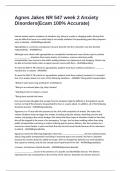Exam (elaborations)
Agnes Jakes NR 547 week 2 Anxiety Disorders(Ecam 100% Accurate)
- Course
- Institution
intense anxiety and/or avoidance of situations (eg, being in crowds or shopping malls, driving) that may be difficult to leave or in which help is not readily available if incapacitating panic-like symptoms were to develop - ANSWERAgoraphobia Agoraphobia is a common consequence of panic disorder, ...
[Show more]



